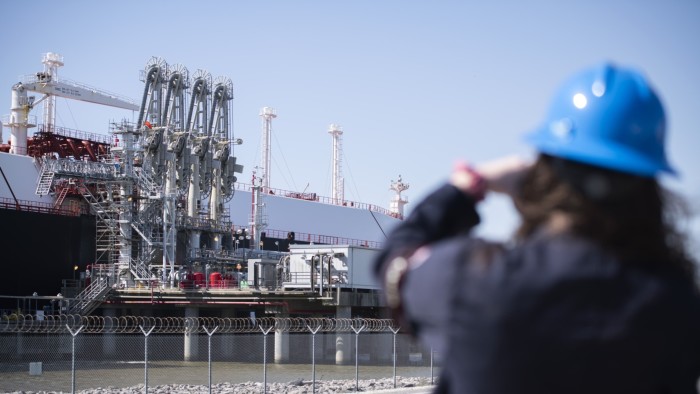President Donald Trump has threatened the EU with a trade war if it doesn’t buy more US oil and gas. But even though Brussels has shown openness to the idea, it has no purchasing authority and European countries are importing record amounts of cheap liquefied natural gas from Russia.
The question of whether Europe can act as a bloc and buy more American fuel looms large over transatlantic relations after the inauguration of the next U.S. president on Monday.
“Buy our oil and gas at scale. Otherwise it’s tariffs forever!!!” Trump posted on social media last month.
Immediately after her re-election, European Commission President Ursula von der Leyen supported the idea: “What if we replaced[Russian gas]with American LNG?”
But the EU executive body can only signal to the U.S. president-elect that European companies, not gas buyers, are interested in American LNG, officials and analysts say.
The European Union has pledged to buy more LNG from the United States in 2022. Officials said there are no immediate plans to renew this commitment.
“What conditions need to be in place for this to happen? We are not going to revisit everything on January 21st,” said one EU official.

The fundamental problem is the bloc’s inability to divest from cheap Russian fossil fuels. Last year, EU companies imported record amounts of LNG from the country.
“That LNG should come from the United States,” said Mike Somers, chief executive of the American Petroleum Institute, the nation’s largest oil and gas lobby.
Fearing a tightening of supplies after Russia phased out pipeline gas to Europe, the EU banned LNG, as it did with Russian coal, and banned LNG, which was transported by tanker as in the case of Russian oil. However, the agreement did not lead to setting a price ceiling on Russian LNG.
Instead, the EU set an indicative target of a complete withdrawal from all fossil fuels in Russia by 2027 and allowed the government to ban the country’s exporters from using EU gas infrastructure. Some ministers have complained that this is not enough to force companies to abandon existing contracts.
EU diplomats involved in the negotiations said LNG could be included in new sanctions, but that would require unanimous approval from 27 member states, with Hungary and Slovakia likely to oppose it. .
US President Joe Biden’s administration added two small Russian LNG facilities to the US sanctions list this month, but balked at listing Yamal, a major base supplying Europe and other parts of the world. I’m here.
Tatiana Mitrova, an analyst at the Global Energy Policy Center, said she expected the Trump administration to impose tougher sanctions on Yamal, given how the president-elect plans to push for more U.S. LNG exports to Europe. He said it would be a “very logical” move to introduce it.
US industry is confident it has more than enough spare capacity to displace Russian LNG from Europe’s energy mix.
S&P Global Commodities Insights said a total of 10.3 million tonnes of LNG from the U.S. plant under construction has already been contracted for Europe. An additional 9.5 million tonnes will also be offered to buyers, including from Europe. These volumes would exceed the 17 million tonnes of Russian LNG the EU imported last year and “will come online in 2029 or well before”, S&P said.
As one of his first actions after taking office, President Trump promised to lift the freeze on new LNG export capacity imposed by the previous administration.
The EU also has scope to increase imports to regasification terminals, where transported liquefied fuels are turned back into gas.

However, price sensitivity is a big issue. The EU is struggling to appease President Trump while protecting its industry and lowering high energy prices, especially in Germany, Europe’s largest economy.
Gasoline prices in the EU are roughly more than three times as expensive as in the United States, and stubbornly remain at more than twice the price they were before Russia’s full-scale invasion of Ukraine in 2022.
“The price issue is a sensitive and decisive issue,” said a senior EU official.
Anatol Feigin, chief commercial officer of Houston-based LNG exporter Cheniere Energy, told the Financial Times that commercial decisions and price signals, not government mandates, determine U.S. LNG flows to Europe. Then he spoke.
“The United States is very different from Qatar and other parts of the world. There is no direct government-to-government dealing,” he said.
One way for Brussels and other EU governments to get involved is to set up a strategic LNG stockpile that could include U.S. shipments, Feigin suggested.
EU natural gas demand is expected to fall by up to 25% by 2030 compared to 2023 levels, according to International Energy Agency forecasts, with countries such as Qatar and Canada also planning to ramp up production online. is.
“We are at the beginning of a new wave of LNG supplies,” said Michael Stoppard, head of global gas strategy at S&P Global Commodity Insights. “With each passing year, it will become easier for Europe to have alternatives to Russian LNG, especially after 2026.”
Data visualization by Shotaro Tani and Ray Douglas



